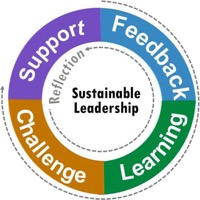Leadership Challenge
- A high potential employee is promoted into a first level supervisor role and within months department productivity is at an all time low.
- A mid-level rising star manager is recruited to a cutting edge corporation and, within a year, she successfully hired three other rising stars from her former employer…you.
- Production line employees have experienced management turnover three times in the past six months. They wonder what upper management is thinking.
- A new “take charge” leader takes over a sluggish division and restructures it with a “my way or the highway” approach. Within 6 months, he has lost half of his top talent to other departments and the competition.
In an increasingly complex and uncertain economic environment, organizations must continually ask themselves: “Are we developing leaders at all levels for the long term? How are we teaching, mentoring, coaching, and giving relevant feedback for a leader’s growth? What is our succession planning strategy organizationally, not just at the senior level? How are we assessing our bench strength and building our leadership pipeline? Are we building a solid foundation of leadership using a blueprint that best fits our organization? What is ‘our’ architecture of leadership?” That is sustainable leadership!
The Learning Solution
“In the world of leadership, sustainability has never been more relevant.” -Steve Kuper
The hallmark of ILS is our relentless pursuit of excellence and our ability to discover and create practical, innovative, engaging, and results-based learning experiences for our clients. An organization builds sustainable leadership on a solid learning foundation. The Architecture of Leadership process helps create that foundation by developing skills including but not limited to: coaching and mentoring, fostering a culture of feedback – formal and informal, making projects available that are challenging, and by sharing best practices across department lines.
Our Approach
ILS approaches the learning experience in a way that “stretches” leaders within the organization to a place of growth. Our philosophy of “working within to bring out the best”TM is seen in our unique approach of working in tandem with the organization so as to support the desired organizational culture while “pushing the envelope” during the learning experience. We believe senior leadership should undertake The Architecture of Leadership first. The logic behind this is that it creates alignment in an organization as subsequent levels follow. It also provides senior leaders with an understanding of what their direct reports are experiencing so they can coach and mentor appropriately. The following components are included in our leadership development process:

Coaching and 360-Degree Feedback
In creating a culture of learning and feedback, it is vitally important to get feedback. One of the formal ways to facilitate this process is through the 360-degree feedback tool. One of the most significant trends in the leadership development field over the past twenty years has been the growth of this process. [1] It has been called one of the most notable management innovations in recent times. [2]
In its simplest terms, feedback in the context of an organization refers to the information a person receives from co-workers related to his or her work behavior. Traditionally, performance feedback in organizations has come from a single source, the boss. There are problems with this approach in that it is a single source of collecting performance information; it provides a limited perspective. It can also be subject to bias, which affects the quality and accuracy of the feedback. In the case of managers assessing direct reports, they often lack the time or opportunity to observe their employees in all situations. Employees may behave one way with their bosses and a different way with their peers. Receiving feedback from several sources is clearly desirable. [3]
Because of the power and relevance that feedback plays in the development process, ILS believes it is valuable for participants to take part in the 360 Feedback process. Launching it with senior leadership sends a strong message through out the organization that feedback is valuable for all.
Coinciding with the 360 Process, ILS offers leadership coaching in a one-on-one confidential environment. With the feedback provided from the 360, the coach and employee meet to discuss the results, implications of the feedback and to put together a Development Plan. Together the coach and employee work through the development plan and the ongoing challenges that the employee faces in his/her role in the organization.
Classroom Learning
The Architecture of Leadership series kicks off with a two-day intensive learning experience (often done in retreat format) that “baptizes” the participants in a philosophy and thought process around leadership. Following this initial two day experience, subsequent sessions are facilitated focusing on key competencies needed at the various leadership levels in the organization.
Each session is custom designed to be relevant, vibrant and impactful, engaging the learner at every step along the way, thus leveraging the learning experience and creating an organization that is on the cutting edge of its industry. The partnership and design process is approached with four key results in mind:
- Impact on the learner as well as the organization;
- Performance improvement;
- Cultural alignment; and
- Competitive edge.
Classroom Themes
Welcome to a Manager’s World
Establishing a Foundation of Leadership
The Good, The Bad and The Ugly
Seeking and Receiving Feedback for Professional Development
DISC
Managing a Team with Multiple Personalities
Speak Up and Listen
Effective Communication Rules the Day
Only 10 hours in a day?
Time Management through Priority Setting and Delegation
Reward and Recognition
The Difference Between the Two and How to Motivate Others
Running Away is Not an Option
Effective Conflict Management using the TKI Assessment
The Manager as Coach
Performance Feedback that Gets Results
That’s Not the Way I See It
Conversations on Diversity in the Workplace
Presenting UP
Presentation Skills
Support
To further create a culture of sustainable leadership, support is needed for those in the learning process. This can be accomplished in a variety of ways. The two areas we will focus on are coaching and participant meetings with his/her manager.
A more formal approach to coaching will take place between the team at ILS and the participants in the class during the first rotation of The Architecture of Leadership. This will be accomplished four to six times during the year and will include the feedback gathered from the 360-Degree Feedback Process as well as various issues that the manager is dealing with in their daily environment.
The philosophy behind this is that the participants will not only be coached, but coaching will be roll-modeled for them so they’re ready to be the “formal coaches” during the second rotation of the process.
In addition to coaching, participants will be expected to meet with their manager on a regular basis to review their Professional Development Plan (pdp). This is an action plan that participants create and update during each session, based on the learning that takes place in the class.
Challenges
The Center for Creative Leadership has found through continuous studies of managers’ growth and development that a variety of leadership challenges- certain jobs, exceptional other people (overwhelming bosses), coping with our mistakes, enduring hardships, and course work at pivotal moments-all contribute to the building of seasoned managers. By exposing managers to developmental jobs and developmental bosses, and by helping them become effective learners, we can increase our pool of potential leadership talent for the future and provide more meaningful work for managers. [4]
Throughout our time together, ILS will either make recommendations for stretch assignments or ask participants to seek out their own opportunities for such growth. During coaching and classroom sessions, participants will have opportunities to talk about those assignments and share the learning that is taking place during them.
Reflection
The ability to reflect critically on one’s experience, integrate knowledge gained from experience with knowledge possessed, and take action on insights is considered by some adult educators to be a distinguishing feature of the adult learner. [5] Through the process of critical reflection, adults come to interpret and create new knowledge and actions from their ordinary and sometimes extraordinary experiences. Critical reflection blends learning through experience with theoretical and technical learning to form new knowledge constructions and new behaviors or insights. [6]
Throughout The Architecture of Leadership learning experience, participants are encouraged to reflect on the learning that takes place both inside and outside the classroom. They are provided a journal to capture their thoughts throughout the process including: learning experiences, coaching and feedback given to them, and interactions with their manager and others in the organization. This journal also contains their pdp (Professional Development Plan) so that they can tie their action plans and learning reflection together in an easy manner.
Final Thoughts
How does one build sustainable leadership? Sustainable leadership is built in a very purposeful manner. It will not happen just because an employee performs well at a certain level of the organization. As our opening scenarios illustrate, many well intentioned great performers have been put in leadership roles only to fail. No, sustainable leadership is created when you prepare an employee for their next role in the organization. Sometimes this process is more formal, as suggested here, other times it is more informal. But what is essential is that there is always a strong plan in place.
The Architecture of Leadership builds a solid foundation for learning and growth. It provides a clear blue print for the organization. It creates an organization that has sustainable leadership.
References
- Chappelow, 2004
- Atwater & Waldman, 1998
- Adapted from Leveraging the Impact of 360-Degree Feedback; Chappelow
- Adapted from: Eighty-eight Assignments for Development in Place
- Brookfield 1998; Ecclestone 1996; Mezirow 1991
- David Stein: Teaching Critical Reflection
